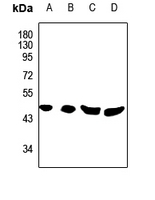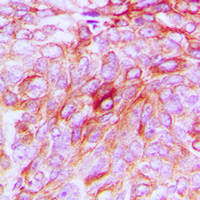Anti-Phospholipase D4 Antibody
Rabbit polyclonal antibody to Phospholipase D4
- 产品详情
- 实验流程
- 背景知识
Application
| WB, IHC |
|---|---|
| Primary Accession | Q96BZ4 |
| Other Accession | Q8BG07 |
| Reactivity | Human, Mouse, Rat |
| Host | Rabbit |
| Clonality | Polyclonal |
| Calculated MW | 55626 Da |
| Gene ID | 122618 |
|---|---|
| Other Names | C14orf175; Phospholipase D4; PLD 4; Choline phosphatase 4; Phosphatidylcholine-hydrolyzing phospholipase D4 |
| Target/Specificity | KLH-conjugated synthetic peptide encompassing a sequence within the C-term region of human Phospholipase D4. The exact sequence is proprietary. |
| Dilution | WB~~WB (1/500 - 1/1000), IHC (1/100 - 1/200) IHC~~WB (1/500 - 1/1000), IHC (1/100 - 1/200) |
| Format | Liquid in 0.42% Potassium phosphate, 0.87% Sodium chloride, pH 7.3, 30% glycerol, and 0.09% (W/V) sodium azide. |
| Storage | Store at -20 °C.Stable for 12 months from date of receipt |
| Name | PLD4 {ECO:0000303|PubMed:30111894, ECO:0000312|HGNC:HGNC:23792} |
|---|---|
| Function | 5'->3' exonuclease that hydrolyzes the phosphodiester bond of single-stranded DNA (ssDNA) and RNA molecules to form nucleoside 3'- monophosphates and 5'-end 5'-hydroxy deoxyribonucleotide/ribonucleotide fragments (PubMed:30111894, PubMed:34620855, PubMed:38537643, PubMed:39423811). Partially redundant with PLD3, can cleave all four nucleotides displaying higher efficiency for ssDNA and RNA fragments initiated with uridine and guanosine residues and lower efficiency for cytidine-initiated substrates (PubMed:30111894, PubMed:34620855, PubMed:38537643, PubMed:39423811). As a result, it does not always degrade polynucleotides to the single nucleotide level, it can stall at specific sites sparing certain fragments from exonucleolytic degradation (PubMed:30111894, PubMed:34620855, PubMed:38537643, PubMed:39423811). Processes self and pathogenic ssDNA and RNA molecules that reach the endolysosomal compartment via phagocytosis or autophagy and may serve as 'danger' signals for recognition by innate immune receptors such as toll-like receptors (TLRs) (PubMed:38697119). Degrades mitochondrial CpG-rich ssDNA fragments to prevent TLR9 activation and autoinflammatory response, but it can cleave viral RNA to generate ligands for TLR7 activation and initiate antiviral immune responses (PubMed:38697119). In plasmacytoid dendritic cells, it cooperates with endonuclease RNASET2 to release 2',3'-cyclic guanosine monophosphate (2',3'-cGMP), a potent stimulatory ligand for TLR7 (PubMed:38697119). Produces 2',3'-cGMPs and cytidine-rich RNA fragments that occupy TLR7 ligand-binding pockets and trigger a signaling- competent state (PubMed:38697119). Can exert polynucleotide phosphatase activity toward 5'-phosphorylated ssDNA substrates although at a slow rate (PubMed:38537643). Transphosphatidylase that catalyzes the exchange with R to S stereo-inversion of the glycerol moiety between (S,R)-lysophosphatidylglycerol (LPG) and monoacylglycerol (MAG) substrates to yield (S,S)-bis(monoacylglycero)phosphate (BMP) (PubMed:39423811). Can synthesize a variety of (S,S)-BMPs representing the main phospholipid constituent of lysosomal intralumenal vesicle (ILV) membranes that bind acid hydrolases for lipid degradation (PubMed:39423811). Regulates the homeostasis and interorganellar communication of the endolysosomal system with an overall impact on cellular removal of dysfunctional organelles via autophagy as well as proper protein and lipid turnover. May play a role in myotube formation in response to ER stress (By similarity). |
| Cellular Location | Endoplasmic reticulum membrane {ECO:0000250|UniProtKB:Q8BG07}; Single-pass type II membrane protein {ECO:0000250|UniProtKB:Q8BG07}. Golgi apparatus, trans-Golgi network membrane {ECO:0000250|UniProtKB:Q8BG07}; Single-pass type II membrane protein {ECO:0000250|UniProtKB:Q8BG07}. Nucleus {ECO:0000250|UniProtKB:Q8BG07}. Early endosome {ECO:0000250|UniProtKB:Q8BG07}. Cytoplasmic vesicle, phagosome {ECO:0000250|UniProtKB:Q8BG07}. Lysosome Note=Activation of microglia induces translocation of PLD4 from the nucleus to the phagosomes. {ECO:0000250|UniProtKB:Q8BG07} |
| Tissue Location | Expressed in plasmacytoid dendritic cells and monocytes (at protein level). |
Research Areas
For Research Use Only. Not For Use In Diagnostic Procedures.
Application Protocols
Provided below are standard protocols that you may find useful for product applications.
BACKGROUND
KLH-conjugated synthetic peptide encompassing a sequence within the C-term region of human Phospholipase D4. The exact sequence is proprietary.
终于等到您。ABCEPTA(百远生物)抗体产品。
点击下方“我要评价 ”按钮提交您的反馈信息,您的反馈和评价是我们最宝贵的财富之一,
我们将在1-3个工作日内处理您的反馈信息。
如有疑问,联系:0512-88856768 tech-china@abcepta.com.
¥ 1,500.00
Cat# AP60360























 癌症的基本特征包括细胞增殖、血管生成、迁移、凋亡逃避机制和细胞永生等。找到癌症发生过程中这些通路的关键标记物和对应的抗体用于检测至关重要。
癌症的基本特征包括细胞增殖、血管生成、迁移、凋亡逃避机制和细胞永生等。找到癌症发生过程中这些通路的关键标记物和对应的抗体用于检测至关重要。 为您推荐一个泛素化位点预测神器——泛素化分析工具,可以为您的蛋白的泛素化位点作出预测和评分。
为您推荐一个泛素化位点预测神器——泛素化分析工具,可以为您的蛋白的泛素化位点作出预测和评分。 细胞自噬受体图形绘图工具为你的蛋白的细胞受体结合位点作出预测和评分,识别结合到自噬通路中的蛋白是非常重要的,便于让我们理解自噬在正常生理、病理过程中的作用,如发育、细胞分化、神经退化性疾病、压力条件下、感染和癌症。
细胞自噬受体图形绘图工具为你的蛋白的细胞受体结合位点作出预测和评分,识别结合到自噬通路中的蛋白是非常重要的,便于让我们理解自噬在正常生理、病理过程中的作用,如发育、细胞分化、神经退化性疾病、压力条件下、感染和癌症。







